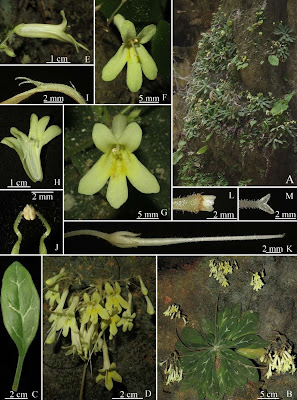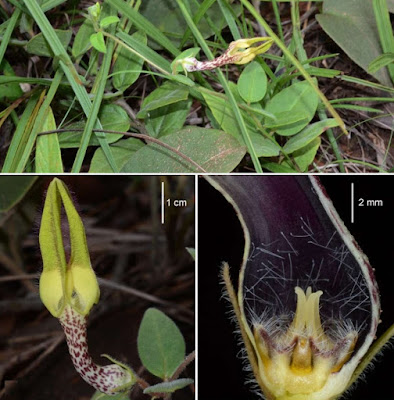[Most Recent Entries] [Calendar View]
Friday, October 5th, 2018
| Time | Event | ||||
| 3:27a | [Botany • 2018] Viola pluviae (Violaceae) • A Member of Subsect. Stolonosae in the Pacific Northwest Region of North America
Abstract As hirtherto circumscribed, the allo‐octoploid Viola palustris L. exists in three distinct races in North America. The race occurring in the Pacific Northwest of North America has previously been shown to have originated by polyploidy from a different set of ancestral tetraploids than the nominal, Amphi‐Atlantic race. These two races differ also in a number of morphological characters, which has been a historical source of confusion. We here propose a new name for the western plants, Viola pluviae Marcussen, H.E. Ballard & Blaxland, and typify it with a specimen collected near Mt Rainier (USA, Washington) with known chromosome number. Distribution, phylogenetic history and taxonomy are discussed and an updated morphological key to the Pacific Northwestern species of Viola is presented. Key words: Viola palustris, bog violet, Plagiostigma, allopolyploid, Pleistocene Viola pluviae Marcussen, H.E. Ballard & Blaxland sp. nov. Etymology: Viola pluviae literally translates to ‘rain’s violet’ in reference to the rainy, coastal climate where it occurs. The pun on the name of the type locality, Mt Rainier, is of course entirely unintended. Distribution: Viola pluviae is widespread along the Pacific coast from northern California to southern Alaska, the Cascades, and parts of the Rocky Mountains (Montana, Idaho). Kim Blaxland, Harvey E. Ballard and Thomas Marcussen. 2018. Viola pluviae sp. nov. (Violaceae), A Member of Subsect. Stolonosae in the Pacific Northwest Region of North America. Nordic Journal of Botany. 36(9) e01931 DOI: 10.1111/njb.01931 | ||||
| 3:51a | [Herpetology • 2018] Liolaemus evaristoi • Description and Phylogenetic Relationships of A New Species of Liolaemus (Iguania: Liolaemidae) and Notes on the L. montanus group of Peru
Description and phylogenetic relationships of a new species of Liolaemus (Iguania: Liolaemidae) and notes on the L. montanus group of Peru. A new lizard species of the Liolaemus montanus group endemic of the Andes western slope, Huaytará Province, Huancavelica, Peru is described. This new species of Liolaemus is of medium size (maximum SVL 70.1 mm) and is characterized by presenting a unique color standard in males, where several light-blue scales on the back and side of the body are prominent, and the abdomen is of an intense yellow. Also, the scales of the back and sides of the body are sub-imbricated, with a slight keel and its shape is rounded to triangular. While females, as well as males exhibit pre-cloacal pores. The combination of several states of morphological, morphometric and flake characters and their color standard clearly differentiate these new taxa of the other Liolaemus species, especially of the members of the L. montanus group described for the center and south of Peru. Also, in this study, we present a revision of the taxonomic status and distribution of species of the L. montanus group described or cited for Peru Key words: Lizards; Distribution; Taxonomy; Morphology; Huancavelica.
Liolaemus evaristoi sp. nov. Liolaemus sp. 2. Gutiérrez et al. 2013, Chapter in Smithsonian Institution Scholarly Press, 429 Pp. (Figs. 1–3) .... Etimología: Dedicamos el nombre científico de esta especie al Dr. Evaristo López Tejeda, Profesor Principal de la Cátedra de Zoología y Director del Museo de Historia Natural de la Universidad Nacional de San Agustín de Arequipa, Perú. Por su continua contribución al conocimiento de la biodiversidad del Sur del Perú, especialmente en el estudio de los reptiles del departamento de Arequipa, así como por su amistad, constante apoyo y asesoramiento, por lo que amerita la dedicatoria de esta nueva especie de Liolaemus. Dr. Evaristo López Tejeda, Principal Professor of the Chair of Zoology and Director of the Museum of Natural History of the National University of San Agustín de Arequipa, Peru. Resumen: Se describe una nueva especie de lagartija del grupo de Liolaemus montanus, endémico de lavertiente occidental de los Andes, en la provincia de Huaytará, departamento de Huancavelica,Perú. Esta nueva especie de Liolaemus, es de tamaño medio (máximo LHC 70,1 mm),se caracteriza por presentar un patrón de coloración único en los machos, donde numerosasescamas celestes se destacan sobre el dorso del cuerpo y el vientre es de color amarillo intenso.Además tiene las escamas del dorso y lados del cuerpo subimbricadas, con quilla leve y deforma redondeada a triangular. Tanto machos como hembras tienen poros precloacales. Lacombinación de varios estados de caracteres morfológicos, morfométricos, de escamación, yen el patrón de coloración, diferencian claramente este nuevo taxón de las demás especies de Liolaemus, especialmente de los integrantes del grupo de L. montanus descritos para el centroy sur del Perú. Asimismo, en este trabajo, presentamos una revisión del estado taxonómico ydistribución de las especies del grupo de L. montanus descritas o citadas para Perú. Palabras clave: Lagartijas; Distribución; Taxonomía; Morfología; Huancavelica.; Roberto Gutiérrez, Juan Carlos Chaparro, Meylin Y. Vásquez, Aarón Josue Quiroz, Álvaro Aguilar Kirigin and Cristian Simon Abdala. 2018. Descripción y relaciones filogenéticas de una nueva especie de Liolaemus (Iguania: Liolaemidae) y notas sobre el grupo de L. montanus de Perú / Description and Phylogenetic Relationships of A New Species of Liolaemus (Iguania: Liolaemidae) and Notes on the L. montanus group of Peru. Cuad. herpetol. 32(2); 81-99. DOI: 10.31017/CdH.2018.(2017-034) Researchgate.net/publication/328027572_u | ||||
| 10:07a | [Botany • 2018] Primulina yandongensis (Gesneriaceae) • A New Species from southwestern Guangxi, China
ABSTRACT Primulina yandongensis, a new species from the limestone area of southwestern Guangxi, China is described and illustrated. It is similar to P. pungentisepala (W. T. Wang) Mich. Möller & A. Weber in morphology, but it is easily distinguished from the latter by some of the distinct characters in cyme, corolla, filament, staminode and phenology. The detailed information, including morphological descriptions, illustrations and diagnostic comparisons etc. are provided. KEY WORDS: China, Gesneriaceae, Limestone flora, New species, Primulina yandongensis. Primulina yandongensis Ying Qin & Yan Liu, sp. nov. 燕峒報春苣苔 Type: CHINA. Guangxi, Baise City, Debao County, Yandong Town, elev. 559 m, ..., 26 September 2017, Debao expedition team of Chinese traditional medicine, 451024170926007LY (holotype: IBK!, isotypes: IBK!). The new species similar to Primulina pungentisepala (W. T. Wang) Mich. Möller & A. Weber in morphology, but it differs from the latter by its inflorescence 11–28- flowered, yellow corolla, thinner tube, filaments sparsely glandular-puberulent, 3 staminodes pubescent and sparsely glandular-puberulent. .... Distinguishing characters: Primulina yandongensis is morphologically close to P. pungentisepala. Shared characters mainly include leaf with similar shape and veins, peduncle with similar length and indumentum, bracts with similar shape and indumentum. However, P. yandongensis can be easily distinguished from the latter by its inflorescence 11–28-flowered, yellow corolla, tube 1.4–1.8 cm long, 5–8 mm in diameter at the mouth. Etymology: The epithet is derived from the type locality Yandong Town, Daobao County, Baise City, Southwestern Guangxi, China. Distribution, habitat and ecology: Primulina yandongensis was known only from the limestone areas of Yandong Town, Debao County, Baise City, Southwestern Guangxi, China. This new species were found from the cliffs of karst tiankengs, or from the entrance of karst caves, and companied by Hymenodictyon flaccidum Wallich, Miliusa sinensis Finet & Gagnepain, Strophioblachia fimbricalyx Boerlage, Trigonostemon thyrsoideus Stapf, Excoecaria cochinchinensis var. viridis (Pax & K. Hoffmann) Merrill, Alchornea trewioides (Bentham) Müller Argoviensis, Rinorea bengalensis (Wallich) Kuntze, Cipadessa baccifera (Roth) Miquel, Maesa perlarius (Loureiro) Merrill, Tinomiscium petiolare Miers ex J. D. Hooker & Thomson, Paphiopedilum hirsutissimum (Lindley ex Hooker) Stein, Begonia chingii Irmscher, Begonia edulis H. Léveillé, etc. ... Ying Qin, Quan Yuan, Wei-Bin Xu and Yan Liu. 2018. Primulina yandongensis (Gesneriaceae), A New Species from southwestern Guangxi, China. Taiwania. 63(4); 305-310. | ||||
| 10:30a | [Botany • 2018] Ceropegia foetidiflora (Asclepiodoideae, Apocynaceae) • A New Species from northeastern Thailand
ABSTRACT A newly discovered species from northeastern Thailand, Ceropegia foetidiflora Kidyoo, is here described and illustrated. Photographs and diagnostic comparison with the morphologically similar species, C. thorelii Costantin, are provided. These two species display clear difference in hairiness on the surfaces of the corolla tube and the corolla lobes, and shape of the corolla lobes. KEY WORDS: Apocynaceae, Asclepiadoideae, Northeastern Thailand, Open sandy area, Strong musty smell.
Ceropegia foetidiflora Kidyoo, sp. nov. Ceropegia foetidiflora is distinguished from C. thorelii by its corolla tube which is glabrous outside, lanceolate-oblong corolla lobes that are nearly as long as the tube and densely pubescent on the adaxial surface and glabrous on the abaxial surface. Contrarily, C. thorelii bears pubescent corolla tube, ovate-lanceolate corolla lobes that are shorter than the tube and hairy on the midrib of the adaxial surface and pubescent on the abaxial surface as well as margins. Type: THAILAND. Phu Langka National Park, Bueng Kan Province, 520 m a.s.l., 14 August 2012, M. Kidyoo 1557 (holotype: BKF, isotype: BCU). Habitat, ecology and distribution: Ceropegia foetidiflora occurs about 520 m a.s.l. in Phu Langka National Park, Bueng Kan Province, northeastern Thailand (Fig. 3). It is perennial herb growing in sandy soil, open areas of dry deciduous dipterocarp forest. Flowering July–October. Manit Kidyoo. 2018. Ceropegia foetidiflora sp. nov. (Asclepiodoideae, Apocynaceae), A New Species from northeastern Thailand. Taiwania. 63(4); 327-332. DOI: 10.6165/tai.2018.63.327 |
| << Previous Day |
2018/10/05 [Calendar] |
Next Day >> |












